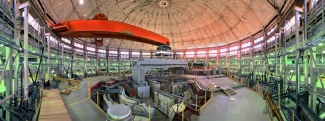The Markus Raschke group has come up with an innovative way that may one day allow it to peer inside superconductors, new materials for solar cells, or even a single cell and identify the inner workings of these complex systems. The new method is able to determine where the different chemical constituents are located and how their spatial distribution determines their function.
The new method is called synchrotron infrared (IR) nanospectroscopy, or SINS. It combines scanning probe microscopy with IR synchrotron radiation, which is intense, directional, coherent, and spans a broad range of IR wavelengths ranging from 2 to 15 µm. This range of wavelengths is critical for detecting and identifying electronic and vibrational states in semi- and superconductors, polymers, biomolecules and other materials.
The first-ever SINS experiment was reported online by the Proceeding of the National Academy of Sciences USA on May 6, 2014. The experiment was a collaboration of the Raschke group and members of the Advanced Light Source (ALS) Division that houses the synchrotron at the Lawrence Berkeley National Laboratory. The research team included research associate Eric Muller, former graduate student Robert Olman, Fellow Adjunct Markus Raschke, and ALS Beamline Scientist Michael Martin and Senior Scientific Engineering Associate Hans Bechtel.
The innovative experiment probed the surface characteristics of a silicon-based semiconductor material, identified distinct crystal structures of calcium carbonate (CaCO3) in a seashell, and analyzed protein nanostructures attached to a surface. The researchers were able to identify spatial variations in chemical structures of just a few molecules with a resolution of just a few nanometers.
The synchrotron experiment was the culmination of nearly a decade of effort inspired by a successful test experiment in 2005 by undergraduate student Jana Puls in Raschke’s lab at the Berliner Elektronenspeicherring-Gesellschaft fur Synchrontronstrahlung (BESSY), a national lab in Berlin, Germany.
“When I first saw the unique properties of infrared synchrotron light back in 2005 at BESSY in Berlin, I thought right away, we have to try using it for nano-spectroscopy,” Raschke said.
Thanks to some modest funding from the Department of Energy in 2008, Raschke was able to begin talks with the ALS staff about the idea of using synchrotron IR radiation in nanoscience investigations. From there, the visionary idea evolved into the successful feasibility study highlighted here.
“What excites me most about this experiment is that we started with a giant machine—the synchrotron—and we were able to focus its infrared power down to the nanoscale with the help of a tiny needle that concentrated the synchrotron light into a tiny region,” Raschke explained. “This process made it possible to study ultramicroscopic processes in matter.” —Julie Phillips




